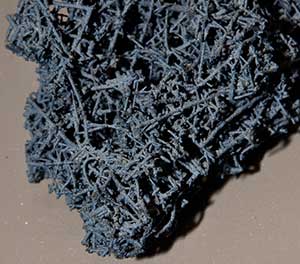 |
| Pyrolusite - MnO2. |
Manganese is a very brittle but hard metallic element. The main ore mineral for manganese is pyrolusite. Known U.S. deposits of manganese are very low grade and have potentially high extraction costs. Most U.S. imports are from Gabon and South Africa. Manganese is mined mainly, in order of tonnage, in South Africa, Brazil, Australia, Ukraine, Gabon, India, and China. It is essential to iron and steel production by virtue of its alloying, deoxidizing, and sulfur-fixing properties. Manganese is also used in aluminum alloys, batteries, colorants, and fertilizers.
Manganese nodules form on the deep ocean floor. They are made up predominantly of manganese oxide and iron oxide. Mining manganese nodules from the deep ocean has been investigated, but such an undertaking will probably not be feasible in the near future because of economic constraints.
Background
Manganese is gray-white metal with a pinkish tinge, and a very brittle but hard metallic element. Its atomic number 25. In 1774, while heating the mineral pyrolusite (MnO2, manganese dioxide) in a charcoal fire, the Swedish scientist Johann Gahn discovered manganese. The heat and carbon in the charcoal separated oxygen from the pyrolusite, leaving a metallic manganese residue. This chemical reaction is called a reduction reaction.
Manganese is a reactive element that easily combines with ions in water and air. In the Earth, manganese is found in a number of minerals of different chemical and physical properties, but is never found as a free metal in nature. The most important mineral is pyrolusite, because it is the main ore mineral for manganese.
Trace amounts of manganese are very important to good health. It makes bones strong yet flexible, and it aids the body in absorbing Vitamin B1. It also is an important activator for the body to use enzymes. As little as 0.00002% Mn in the human body is essential. Studies have shown that a lack of manganese leads to infertility in animals.
Name
The word manganese comes from the Latin word magnes which means magnet, because when manganese is alloyed with other metals like aluminum, copper and antimony, the end product is magnetic.
Sources
Over 80% of the known world manganese resources are found in South Africa and Ukraine. Other important manganese deposits are in China, Australia, Brazil, Gabon, India, and Mexico. The United States imports manganese ore because the manganese resources in the U.S. are relatively low in manganese content per ton of ore. Importing these ores is presently more economic than mining them locally.
Most manganese ore imported to the United States is used to manufacture intermediate manganese ferroalloy products and electrolytic manganese for use in dry-cell batteries. Only a small amount of the ore is directly used in the steel making process.
Some manganese is recovered through the reprocessing of scrap metals and steel slag, or the materials left over from the steel-making process. Though considered waste in terms of its steel content, slag often contains significant amounts of other elements that can be recovered.
Deep-sea nodules of manganese and other metals are scattered on the ocean floor. They form when the hot waters from hot springs (called black smokers) on the ocean bottom meet the cold, deep ocean water. The elements in the hot volcanic waters precipitate as nodules. Though rich in manganese (nearly 25% manganese) they are very deep in the ocean and it would cost too much to make them worth retrieving. This may prove to be an important source of manganese in the future should reserves in the Earth's crust be depleted and cost-effective deep-sea mining methods are discovered.
Uses
Steel becomes harder when it is alloyed with manganese. It has similar applications when alloyed with aluminum and copper. Hardened steel is important in the manufacture of construction materials like I-beams (24% of manganese consumption), machinery (14% of manganese consumption), and transportation (13% of manganese consumption).
Manganese dioxide is used to: manufacture ferroalloys; manufacture dry cell batteries (it's a depolarizer); to "decolorize" glass; to prepare some chemicals, like oxygen and chlorine; and to dry black paints. Manganese sulfate (MnSO4) is used as a chemical intermediate and as a micronutrient in animal feeds and plant fertilizers. Manganese metal is used as a brick and ceramic colorant, in copper and aluminum alloys, and as a chemical oxidizer and catalyst. Potassium permanganate (KMnO4) is used as a bactericide and algicide in water and wastewater treatment, and as an oxidant in organic chemical synthesis.
Substitutes and Alternative Sources
There are presently no adequate substitutes for manganese in its varied applications.